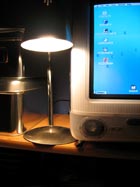

Sprachen:


Fluorescent light could be a risk factor for several skin conditions that are brought on or aggravated by exposure to light.
These are skin conditions (dermatoses) triggered by light (photo) that have no known cause (idiopathic). However, they are believed to involve the immune system, and include:
The most severe cases of these diseases may potentially be at risk from CFLs.
b) Drug-induced photosensitivity
Many drugs cause skin problems and allergic reaction when taken in combination with exposure to sunlight, and light in general. The reactions depend on the drug and include burning, prickling sensations, itching, blistering and reddening of the skin. CFLs are unlikely to be a problem because in many cases only UVA triggers the symptoms and large amounts of drug are needed to produce any effect.
These are hereditary (“geno”, relating to genes) skin diseases (dermatoses) triggered by light (photo). Although they are quite rare and not well understood, patients are advised to avoid unfiltered fluorescent light, including single-envelope CFLs. More ...
d) Porphyrias
This group of rare skin diseases are caused by the accumulation of a type of pigment sensitive to light (porphyrin) within the skin and by a mixture of inherited and environmental factors. Extremely sensitive patients could possibly be at a slightly higher risk from CFLs compared to incandescent sources. More ...
e) Eczema
Sunlight seems to worsen a form of eczema (atopic eczema) in about one in ten patients. It seems unlikely that CFLs would contribute significantly to this problem and might even be preferred to incandescent light sources. More ...
Ultraviolet radiation aggravates this condition characterized by chronic inflammation of body tissues caused by autoimmune disease. Therefore, long-term exposure to CFLs could be a problem for patients. More ...
g) Skin cancers
Ultraviolet radiation is a major environmental risk factor for skin cancer, but the use of CFLs does not contribute significantly to the risk of developing it. Nevertheless, the design of CFLs has to respect the current restrictions for room lighting in terms of the amount of ultraviolet radiation that they emit, particularly in the UVC range. More ...

This summary is free and ad-free, as is all of our content. You can help us remain free and independant as well as to develop new ways to communicate science by becoming a Patron!